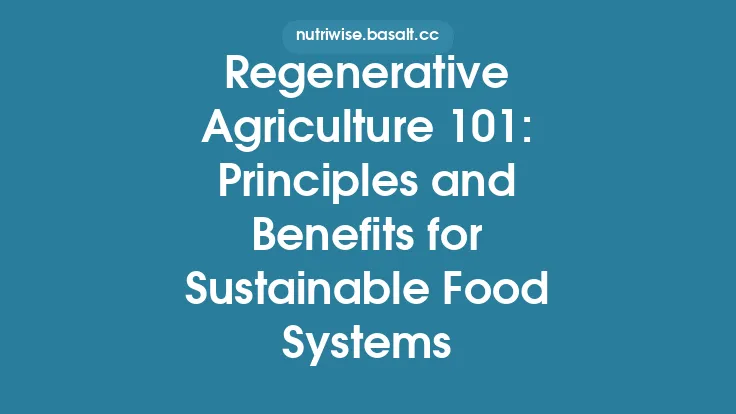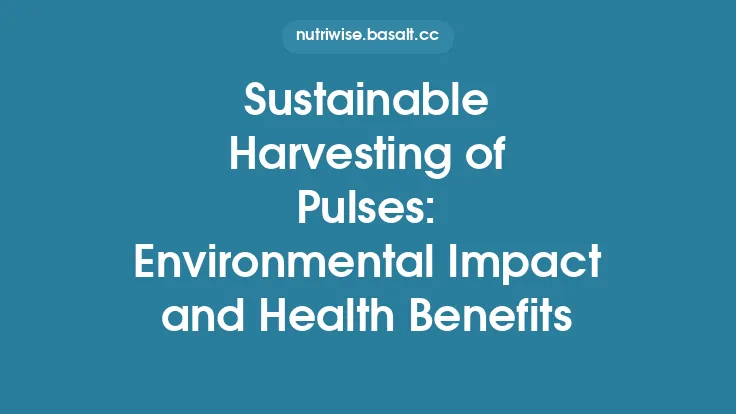Food biodiversity— the variety of species, genetic strains, and functional traits that make up the foods we grow, harvest, and consume— is more than a buzzword. It sits at the intersection of nutrition science, agronomy, and planetary health, offering a suite of benefits that extend from the microscopic world inside our gut to the global climate system. Understanding how this diversity translates into tangible outcomes for human well‑being and the Earth’s ecological balance can guide both personal choices and broader food‑system policies.
What Is Food Biodiversity?
Food biodiversity can be parsed into three interrelated layers:
- Species Diversity – The number of different plant and animal species that enter the food chain, from staple grains to wild greens, legumes, nuts, fish, and insects.
- Genetic Diversity – The variation within a species, such as different cultivars of wheat or strains of rice, each carrying unique traits for flavor, nutrition, and stress tolerance.
- Functional Diversity – The range of biological functions that food species perform in ecosystems, including nitrogen fixation, deep rooting, or pollinator attraction.
These layers together shape the nutritional profile of diets, the stability of food production, and the capacity of agricultural landscapes to provide ecosystem services.
Nutritional Advantages of a Diverse Food Portfolio
A diet that draws from a broad spectrum of species and genetic lines delivers a richer array of macro‑ and micronutrients:
| Nutrient Category | Typical Sources Across Diverse Foods | Health Impact |
|---|---|---|
| Complex Carbohydrates | Whole‑grain millets, quinoa, sorghum, tubers (e.g., cassava, sweet potato) | Sustained energy release, lower glycemic spikes |
| High‑Quality Protein | Legumes (lentils, chickpeas), nuts (almonds, pistachios), fish, insects | Muscle maintenance, satiety, immune support |
| Essential Fatty Acids | Flaxseed, chia, hemp seeds, oily fish, certain algae | Cardiovascular health, anti‑inflammatory pathways |
| Vitamins & Minerals | Dark leafy greens (amaranth, moringa), orange-fleshed sweet potatoes (β‑carotene), seaweed (iodine) | Vision, bone health, thyroid function |
| Phytochemicals & Antioxidants | Berries, cruciferous vegetables, spices (turmeric, ginger) | Cellular protection, reduced chronic disease risk |
When a diet relies heavily on a narrow set of foods, gaps in micronutrient intake become more likely, increasing the risk of deficiencies such as iron‑deficiency anemia or vitamin A insufficiency. By contrast, a biodiverse plate naturally fills these gaps, reducing the need for supplementation and fortification.
Gut Microbiome: The Hidden Connection
The human gut hosts trillions of microbes that co‑evolve with the foods we eat. Diverse dietary fibers— soluble, insoluble, and resistant starches— serve as substrates for distinct microbial taxa. A study published in *Nature Microbiology* (2022) demonstrated that participants who consumed a diet encompassing >30 plant species showed a 45 % increase in microbial gene richness compared with a low‑diversity diet. This heightened microbial diversity correlates with:
- Improved metabolic health (better insulin sensitivity, lower triglycerides)
- Enhanced immune regulation (reduced systemic inflammation)
- Greater resilience to gastrointestinal disturbances (lower incidence of IBS symptoms)
Thus, food biodiversity directly fuels a more robust and adaptable gut ecosystem, which in turn supports overall health.
Resilience to Climate Variability and Food Security
From a planetary perspective, a diversified food system is less vulnerable to climate extremes. Different species and cultivars possess varying tolerances to heat, drought, flooding, and salinity. When a region cultivates a mosaic of crops rather than a single staple, the probability that at least some yield will survive adverse conditions rises dramatically. Modeling by the International Food Policy Research Institute (IFPRI) indicates that a 10 % increase in crop species diversity can reduce the risk of total harvest failure by up to 30 % under projected climate scenarios.
This built‑in redundancy not only safeguards local food supplies but also stabilizes global markets, mitigating price spikes that disproportionately affect low‑income populations.
Resource Efficiency and Environmental Footprint
Food biodiversity can improve the efficiency with which natural resources are used:
- Water Use: Certain legumes (e.g., cowpea) and millets require substantially less irrigation than water‑intensive cereals like rice. Integrating these into cropping systems reduces overall water withdrawal.
- Land Use: Mixed‑species farms often achieve higher total biomass per hectare because complementary root architectures exploit different soil layers, reducing competition for nutrients.
- Pesticide Reduction: Functional diversity— such as intercropping nitrogen‑fixing beans with pest‑repellent herbs— can suppress pest populations naturally, lowering reliance on synthetic chemicals.
Collectively, these efficiencies translate into lower energy consumption, reduced greenhouse‑gas emissions, and diminished pressure on freshwater ecosystems.
Carbon Sequestration and Greenhouse‑Gas Mitigation
Plants capture atmospheric CO₂ through photosynthesis, storing carbon in biomass and soils. Species with deep, fibrous root systems (e.g., certain sorghums, perennial grasses) deposit organic matter deeper into the soil profile, enhancing long‑term carbon sequestration. A meta‑analysis of agroforestry and diversified cropping systems (published in *Global Change Biology*, 2021) found that farms with high species and functional diversity sequestered on average 0.5 t C ha⁻¹ yr⁻¹ more than monoculture farms.
Moreover, diversified diets that incorporate more plant‑based foods tend to have lower life‑cycle emissions per calorie, because animal production is generally more carbon‑intensive. While this article does not focus on the meat‑plant balance for biodiversity per se, the carbon advantage of plant diversity remains a key planetary benefit.
Soil Health and Nutrient Cycling
Soil is a living matrix, and its health hinges on the diversity of organic inputs it receives. Rotating crops with different nutrient demands and residue qualities— for instance, alternating a nitrogen‑fixing legume with a cereal grain— promotes balanced nutrient cycling. This practice reduces the need for synthetic fertilizers, which are energy‑intensive to produce and can cause downstream eutrophication.
Additionally, diverse root exudates stimulate a broader community of soil microbes, including mycorrhizal fungi that improve phosphorus uptake and enhance soil structure. Healthier soils retain water more effectively, further buffering crops against drought.
Policy and Consumer Implications
To harness the health and planetary gains of food biodiversity, coordinated action is required across multiple scales:
- Research Funding: Support interdisciplinary studies that link nutritional outcomes with agronomic performance across diverse species.
- Incentive Programs: Provide subsidies or tax breaks for farmers who adopt multi‑species rotations, cover crops, and agroecological practices.
- Labeling Standards: Develop certification schemes that highlight biodiversity‑rich products, enabling consumers to make informed choices.
- Education Campaigns: Integrate food‑biodiversity concepts into school curricula and public health messaging, emphasizing both personal health and environmental stewardship.
Practical Steps for Individuals
Even without wholesale changes to the food system, consumers can contribute to a more biodiverse diet:
- Explore New Species: Incorporate at least one unfamiliar fruit, vegetable, or grain each week.
- Choose Whole‑Food Forms: Opt for whole beans, seeds, and nuts rather than highly processed equivalents to retain fiber and phytonutrients.
- Seasonal Shopping: Purchase produce that is in season locally, which often includes a wider array of species than year‑round imports.
- Support Diverse Markets: Frequent farmers’ markets, community‑supported agriculture (CSA) shares, and specialty stores that stock a range of cultivars.
- Cook Creatively: Experiment with recipes that blend multiple plant families, thereby exposing the gut microbiome to varied fibers.
By deliberately broadening the spectrum of foods on our plates, we not only enrich our own nutrient intake and gut health but also contribute to a more resilient, low‑impact food system that sustains the planet for future generations.





